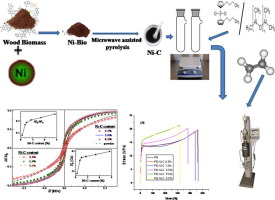当前位置:
X-MOL 学术
›
Eur. Polym. J.
›
论文详情
Our official English website, www.x-mol.net, welcomes your feedback! (Note: you will need to create a separate account there.)
Synthesis of polyethylene/nickel–carbon stimuli-responsive material under magnetic field at room temperature: Effect of the filler on the properties
European Polymer Journal ( IF 6 ) Pub Date : 2018-02-01 , DOI: 10.1016/j.eurpolymj.2017.12.044 Muhammad Nisar , Pascal S. Thue , Cesar A. Heck , J.L. Salazar Cuaila , J. Geshev , Eder C. Lima , Marly M. Jacobi , Griselda Barrera Galland
European Polymer Journal ( IF 6 ) Pub Date : 2018-02-01 , DOI: 10.1016/j.eurpolymj.2017.12.044 Muhammad Nisar , Pascal S. Thue , Cesar A. Heck , J.L. Salazar Cuaila , J. Geshev , Eder C. Lima , Marly M. Jacobi , Griselda Barrera Galland

|
Abstract In this study we investigated the effect of carbon-based magnetic fillers on the thermal, mechanical, morphological and magnetic properties of polyethylene nanocomposites, with the filler range from 0 to 8.5 wt%, prepared by in situ polymerization. The nickel-carbonized material was prepared from biomass by the pyrolysis of wood sawdust. The thermal stability was investigated by thermogravimetric analysis (TGA) and differential calorimetric analysis (DSC); the results show that, with incorporation of the filler, the onset and maximum degradation temperatures increased by 24 and 7 °C, respectively. The DSC results indicate an enhancement of 4 °C in the melting and crystallization temperatures, as compared to neat polyethylene. The addition of the Ni filler resulted in a ferromagnetic behavior of the polyethylene nanocomposites. While the variation on the coercivity with the Ni filler content was very little (a rise of ∼30%), the effect on the normalized remnant magnetization was rather significant, presenting a threefold increase. The mechanical properties showed an improvement, mainly with the higher amount of the filler.
中文翻译:

室温磁场下聚乙烯/镍-碳刺激响应材料的合成:填料对性能的影响
摘要 在本研究中,我们研究了碳基磁性填料对原位聚合制备的聚乙烯纳米复合材料的热、机械、形态和磁性能的影响,填料范围为 0 至 8.5 wt%。镍碳化材料是由生物质通过木屑热解制备的。通过热重分析(TGA)和差示量热分析(DSC)研究热稳定性;结果表明,随着填料的加入,起始降解温度和最大降解温度分别增加了 24 和 7 ℃。DSC 结果表明,与纯聚乙烯相比,熔融和结晶温度提高了 4°C。Ni填料的添加导致聚乙烯纳米复合材料的铁磁行为。虽然矫顽力随 Ni 填料含量的变化很小(增加了约 30%),但对归一化剩磁的影响相当显着,增加了三倍。机械性能显示出改善,主要是填料量增加。
更新日期:2018-02-01
中文翻译:

室温磁场下聚乙烯/镍-碳刺激响应材料的合成:填料对性能的影响
摘要 在本研究中,我们研究了碳基磁性填料对原位聚合制备的聚乙烯纳米复合材料的热、机械、形态和磁性能的影响,填料范围为 0 至 8.5 wt%。镍碳化材料是由生物质通过木屑热解制备的。通过热重分析(TGA)和差示量热分析(DSC)研究热稳定性;结果表明,随着填料的加入,起始降解温度和最大降解温度分别增加了 24 和 7 ℃。DSC 结果表明,与纯聚乙烯相比,熔融和结晶温度提高了 4°C。Ni填料的添加导致聚乙烯纳米复合材料的铁磁行为。虽然矫顽力随 Ni 填料含量的变化很小(增加了约 30%),但对归一化剩磁的影响相当显着,增加了三倍。机械性能显示出改善,主要是填料量增加。



























 京公网安备 11010802027423号
京公网安备 11010802027423号